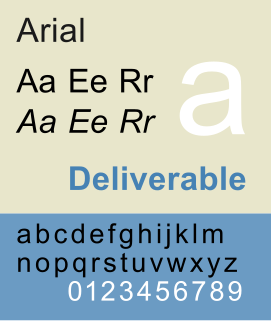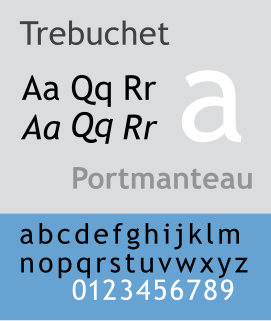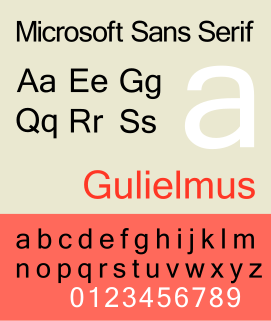
Times New Roman is a serif typeface. It was commissioned by the British newspaper The Times in 1931 and conceived by Stanley Morison, the artistic adviser to the British branch of the printing equipment company Monotype, in collaboration with Victor Lardent, a lettering artist in The Times's advertising department. It has become one of the most popular typefaces of all time and is installed on most desktop computers.

In typography and lettering, a sans-serif, sans serif, gothic, or simply sans letterform is one that does not have extending features called "serifs" at the end of strokes. Sans-serif fonts tend to have less stroke width variation than serif fonts. They are often used to convey simplicity and modernity or minimalism.
In typography, a serif is a small line or stroke regularly attached to the end of a larger stroke in a letter or symbol within a particular font or family of fonts. A typeface or "font family" making use of serifs is called a serif typeface, and a typeface that does not include them is a sans-serif one. Some typography sources refer to sans-serif typefaces as "grotesque" or "Gothic", and serif typefaces as "roman".

A typeface is the overall design of lettering; the design can include variations, such as extra bold, bold, regular, light, italic, condensed, extended, etc. Each of these variations of the typeface is a font.

PagePlus was a desktop publishing program developed by Serif for Microsoft Windows. The first version was released in 1991 as the first commercial sub-£100 DTP package for Microsoft Windows. The final release was PagePlus X9, which was released in November 2016. In June 2019 it was officially replaced by Serif with Affinity Publisher.

Arial, sometimes marketed or displayed in software as Arial MT, is a sans-serif typeface and set of computer fonts in the neo-grotesque style. Fonts from the Arial family are packaged with all versions of Microsoft Windows from Windows 3.1 onwards, some other Microsoft software applications, Apple's macOS and many PostScript 3 computer printers. The typeface was designed in 1982, by Robin Nicholas and Patricia Saunders, for Monotype Typography. It was created to be metrically identical to the popular typeface Helvetica, with all character widths identical, so that a document designed in Helvetica could be displayed and printed correctly without having to pay for a Helvetica license.

Tahoma is a humanist sans-serif typeface that Matthew Carter designed for Microsoft Corporation. Microsoft first distributed it, along with Carter's Verdana, as a standard font in the initial release of Windows 95.
In digital typography, Lucida Sans Unicode OpenType font from the design studio of Bigelow & Holmes is designed to support the most commonly used characters defined in version 1.0 of the Unicode standard. It is a sans-serif variant of the Lucida font family and supports Latin, Greek, Cyrillic and Hebrew scripts, as well as all the letters used in the International Phonetic Alphabet.

Fixedsys is a family of raster monospaced fonts. The name means fixed system, because its glyphs are monospace or fixed-width. It is the oldest font in Windows, and was the system font in Windows 1.0 and 2.0, where it was simply named "System". For Windows 3.x, the system font was changed to a proportional sans-serif font named System, but Fixedsys remained the default font in Notepad.
In HTML and XHTML, a CSS font family property is used to specify a list of prioritized fonts and generic family names; in conjunction with correlating font properties, this list determines the particular font face used to render characters. A font family is a grouping of fonts defined by 9 shared design styles.

Georgia is a serif typeface designed in 1993 by Matthew Carter and hinted by Tom Rickner for the Microsoft Corporation. It was intended as a serif typeface that would appear elegant but legible printed small or on low-resolution screens. The typeface is inspired by Scotch Roman designs of the 19th century and was based on designs for a print typeface in the same style Carter was working on when contacted by Microsoft; this would be released under the name Miller the following year. The typeface's name referred to a tabloid headline "Alien heads found in Georgia".

Lucida Grande is a humanist sans-serif typeface. It is a member of the Lucida family of typefaces designed by Charles Bigelow and Kris Holmes. It’s best known for its implementation throughout the macOS user interface from 1999 to 2014, as well as in other Apple software like Safari for Windows. As of OS X Yosemite, the system font was changed from Lucida Grande to Helvetica Neue. In OS X El Capitan the system font changed again, this time to San Francisco.

Harvard Graphics was a graphics and presentation program for IBM PC compatibles. The first version, titled Harvard Presentation Graphics was released for MS-DOS in 1986 by Software Publishing Corporation (SPC) and achieved a high market share. It was taken off the market in 2017.

Trebuchet MS is a humanist sans-serif typeface that Vincent Connare designed for the Microsoft Corporation in 1996. It is named after the trebuchet, a medieval siege engine. The name was inspired by a puzzle question that Connare heard at Microsoft headquarters: "Can you make a trebuchet that could launch a person from main campus to the new consumer campus about a mile away? Mathematically, is it possible and how?" Connare "thought that would be a great name for a font that launches words across the Internet". Trebuchet MS was the font used for the window titles in the Windows XP default theme, succeeding MS Sans Serif and Tahoma. Released free of charge by Microsoft as part of their core fonts for the Web package, it remains one of the most popular body text fonts on webpages.

Microsoft Sans Serif is a TrueType font introduced with Windows 2000. It is a successor of MS Sans Serif, a proportional raster font introduced in Windows 1.0. Both fonts are very similar in design to Arial and Helvetica. This font was made to match the MS Sans bitmap included in the early releases of Microsoft Windows.

Liberation is the collective name of four TrueType font families: Liberation Sans, Liberation Sans Narrow, Liberation Serif, and Liberation Mono. These fonts are metrically compatible with the most popular fonts on the Microsoft Windows operating system and the Microsoft Office software package, for which Liberation is intended as a free substitute.
Make Compatible is a program developed by Microsoft that is included with Windows 9x operating systems. It changes per-program system settings in Windows to allow Windows 3.1 programs that are tailored specifically to that platform to execute under newer versions. The name of the program image file for Make Compatible is mkcompat.exe, and it is stored in the \Windows\System directory.













